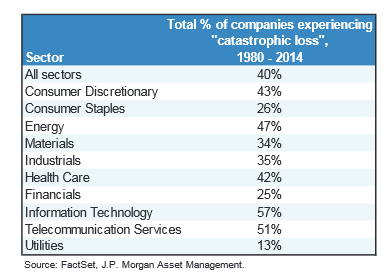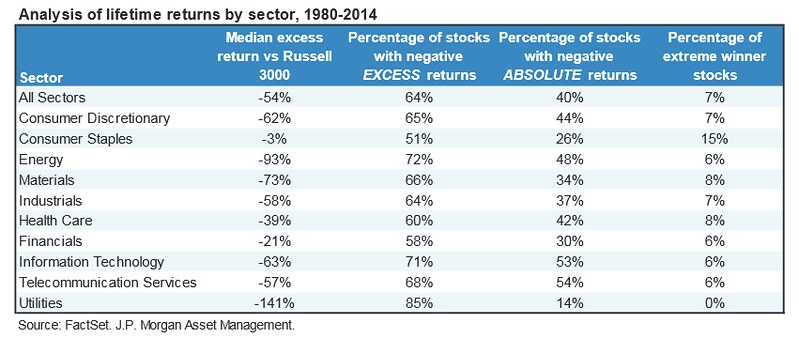You know that feeling you get when you hear of the latest tech IPO? That whisper in your ear that says you know it’s going to be the next big winner. You pass on investing this time, because you were emotionally conflicted and then watch it triple in value, thinking “I knew I should have bought some.”
Instinctively, we know purchasing individual stocks is a risky bet (especially in the short-run) but often our desire to turn our daydreams of winning the lottery in to reality is too overpowering. We secretly look forward to the opportunity to share how smart we are after picking a winner that multiplies exponentially making us wealthy overnight.
This process is known as confirmation bias and can influence our decision making in a manipulative way. After we see a stock increase dramatically that “we had a feeling about,” we promise ourselves, we won’t miss out on the next one. We dive in, without understanding the true risk involved.
The Probability of a Catastrophic Loss

JP Morgan produced an interesting study on the true riskiness of individual stock investments. The research found there is a high probability of a risk of permanent impairment when owning an individual stock. In fact, since 1980, roughly 40% of all stocks suffered a catastrophic loss, defined as a 70% loss from their peak.
For technology, biotech and metals and mining categories of the market, the chances for loss are even higher with over 50% of these holdings experiencing this level of losses.
Additionally, these types of losses don’t happen just during recessions. While elevated losses did spike during recessions, there was still a decent percentage of loss during economic expansions.
The Chance of Success
If you knew you would have a less than 10 percent chance of picking an extreme winner and on average a 60% chance of extreme loss, would you be excited about the investment opportunity? Those are pretty tough odds. You can see the sector breakdown in the chart below of the percentage of stocks in the Russell 3000 index that experienced excess negative returns compared to the index in each sector over the last 34 years. The percentage of excess negative returns varied by sector, but the best case was still a 51% chance in Consumer Staples and a whopping 85% chance in Utilities. Even more surprising, your chances of finding an extreme outperformer were in the single digits with only 6-7% average odds.
Diversification Matters
The reality is making decisions about individual stocks is difficult. The decision of what to buy can be one of the easier decisions. Determining the best time to exit, either after a gain or loss, is the hard part. Above all else, it’s important to understand the amount of risk you are taking when buying individual stocks.
The ability to outperform is very difficult on a consistent basis and is complicated even further by our emotions. Sticking to a diversified strategy that has a focus on discipline, diligence and consistency will help you control your emotions and lower your odds for a catastrophic loss that occurs more often in individual stock holdings.



